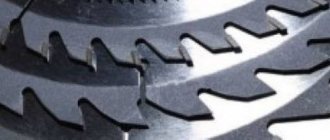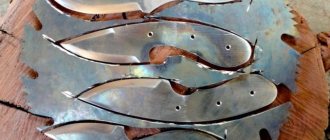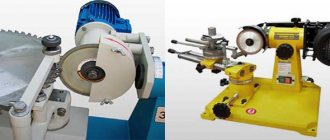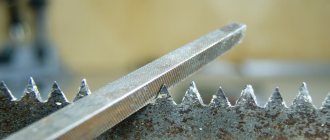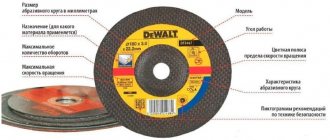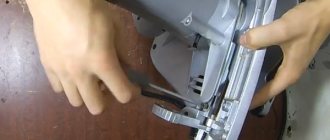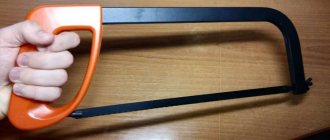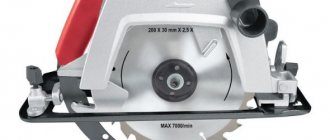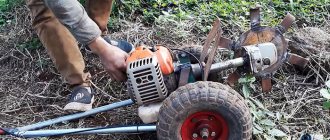Wood sawing ranks high among the main tasks in the construction industry. It is important that the wood after processing remains strong, smooth and does not fall into splinters. There are the following methods for processing wood:
- longitudinal;
- transverse;
- mixed.
The method of cutting wood is chosen depending on the purposes of further use of the workpieces.
Builders often use cross-cutting to process any type of wood. This type of cut is different in that the saw is directed perpendicular to the grain. The quality of the cut determines the amount of waste, the functionality of the parts, the appearance of the processed wood and its readiness for use. For high-quality cross-cutting of wood, craftsmen most often use special saw blades.
Discs for cross-cutting wood are used in conjunction with special saws (circular, hand, miter), with machining centers, with burrs, or formatting machines. Thanks to saw blades, cutting soft and hard wood, plywood, as well as fiberboard and chipboard, exotic wood and thermoplastics has become easier.
Feature of the universal saw blade
The correct selection of consumables for a circular saw is considered a whole science. In this case, it is necessary to take into account certain parameters and correctly compare the characteristic features of each disk model.
Experts recommend choosing products after first reading the opinions of experts. Lack of experience can cause injury at work or cause breakdown of sawing equipment.
- Don't skimp on consumables. Some specialists prefer to use universal types of models that allow them to work with wood and metal structures.
- However, when selecting such an element, it is important to take into account the availability of professional skills.
- Experts say that the disk for a circular saw should be selected taking into account the task at hand.
For example, models with negative tooth angles are used for miter saws. Thanks to them, it is possible to obtain a uniform cut. It is prohibited to select such models for sawing table equipment. The fact is that during the launch process, repulsion of the wood blank is observed.
Increased vibration increases the resistance of the material in contact with the iron base.
Disc products, in which the device is located on the tooth at a negative angle, have an additional row of interdental sinuses. This will increase the number of cutting surfaces. During operation, metal parts are quickly clogged with sawdust. As a result, the speed of work and its results are disrupted.
Saw blades are divided among themselves according to their design features. These include:
- Monolithic. The disc structure is made of dense steel. The advantages of such products are considered to be minimal cost and the ability to independently sharpen metal knives. In addition, the device can be repaired, thereby providing a good margin of safety;
- Carbide. Its base is made of dense steel, and the cutting teeth are made of hard alloy, to which a little tungsten carbide is added. As a result, it is possible to obtain increased hardness in the saw edge area, a uniform cut and an increased interval between sharpening.
Carbide-tipped disc models are designed for high-speed machining on solids. In this way, it is possible to increase the amount of productivity.
The main disadvantage of this design is considered to be proper maintenance. It consists of using special tools and having professional skills.
The service life of saw blades depends on the material
For transverse cutting of wood, circles made of one metal, that is, monolithic, are most often used. There are also models with hard alloy tips, but they are very expensive. Unlike carbide wheels, monolithic wheels are not as durable, they need to be replaced from time to time, and, accordingly, they are cheaper.
To prevent the teeth from becoming dull, they must be sharpened. This procedure is not too complicated, so it can be mastered by non-specialists. Some saw blade teeth are coated with a PTFE layer and polished, so during operation, particles of wood or plastic, as well as sticky resin, do not stick to the surface and the service life of the saw wheel is significantly extended.
You can buy high-quality saw blades for cross-cutting wood at a low price in the online store MNOGOMILL.rf. We sell cutting tools for various purposes.
Disc parameters for circular saws
Before purchasing, you need to consider several important parameters that characterize the operational features. They include.
Diameter
The outer and outer diameters can be determined by taking into account the size of the protective casing. Large products are not suitable for installation on a circular machine with minimal parameters.
The size of the outer diameter does not in any way affect the speed of work and the depth of cut. Experts say that an incorrectly selected diameter of the cutting base contributes to additional load on the electric motor. As a result, the device overheats;
Bore and inner diameter
This parameter is considered one of the most important. There are several sizes that vary from 16 to 32 cm. There may be additional holes or elements on the surface of the disk for more tight fixation on the surface of the pin;
Number of cutting teeth
These elements have a significant impact on the speed of work and its quality. The minimum number of cutting parts reduces the chip removal rate, which affects the frequency of longitudinal cuts.
Professionals claim that the increased number of teeth ensures uniform division of wood fibers. During operation, the engine heating temperature increases;
Inclination of metal teeth
The position of the cutting part can be determined by measuring the inclination from the radius of the disk relative to the plane of the sharp part. A negative slope represents the deflection of the cutting base towards the back side.
- If it is located in the opposite direction, then it is considered positive.
- For slitting, it is best to choose metal teeth with a positive slope.
- This way, the cutting base will evenly grip the material, which will ensure an even cut.
- In turn, slopes are divided into three categories. They may be standard.
In this case, the angle varies from 5 to 20 degrees. If positive, it will range from 15 to 25 degrees. A negative angle is from 0 to minus 10 degrees;
Teeth arrangement
Each cut variety is designed to handle challenging woodworking tasks. They are divided into several categories.
The flat cutter is used for rip cutting at maximum speed.
- It is recommended to choose it for processing soft wood.
- A replacement cutter combines several alternating cutting parts.
- They can be located in the same or directly proportional plane.
A combined cutter combines several groups made in a certain order. This disc is considered a universal model, which is used for complex work.
When sawing plywood with a circular saw, burrs remain. What to do?
Farrier. wrote: The Voltovo PeArshchiki hang out here - DW and Pirahna - ask them, maybe they can advise you.
PS When sawing Makita 5704 with a Makita blade, no such problems were observed when sawing along the grain (I was cutting 12 mm plywood for the floor).
You are apparently worried about the Makita…….
Here is an excerpt from the catalog, these are all discs for ultra-clean cuts of plywood, veneer, soft and hard wood
Designation according to the order Cat. No. Disc diameter Fitting Kerf thickness Number of teeth Tooth geometry Sharpening angle DT4080 150 mm 16 mm 2.6 mm 40 Trapezoidal -5 ° DT4081 150 mm 20 mm 2.6 mm 40 Trapezoidal -5 ° DT4082 150 mm 30 mm 2.6 mm 40 Trapezoidal -5 ° DT4083 160 mm 16 mm 2.6 mm 48 Trapezoidal -5° DT4084 160 mm 20 mm 2.6 mm 48 Trapezoidal -5° DT4085 160 mm 30 mm 2.6 mm 48 Trapezoidal -5° DT4086 165 mm 16 mm 2.6 mm 48 Trapezoidal -5° DT4087 165 mm 20 mm 2.6 mm 48 Trapezoidal -5° DT4088 165 mm 30 mm 2.6 mm 48 Trapezoidal -5° DT4089 170 mm 30 mm 2.6 mm 48 Trapezoidal -5° DT4090 180 mm 20 mm 2.6 mm 48 Trapezoidal -5° DT4091 180 mm 30 mm 2.6 mm 48 Trapezoidal -5° DT4092 184 mm 16 mm 2.6 mm 48 Trapezoidal -5° DT4093 184 mm 20 mm 2.6 mm 48 Trapezoidal -5° DT4095 190 mm 20 mm 2.6 mm 48 Trapezoidal -5° DT4094 190 mm 30 mm 2.6 mm 48 Trapezoidal -5°DT4096 200mm 30mm 2.6mm 56 Trapezoidal -5°DT4098 235mm 25.4mm 3.0mm 56 Trapezoidal -5°DT4097 235mm 30mm 3.0mm 56 Trapezoidal -5°DT4099 240mm 30mm 3 .0 mm 56 Trapezoidal - 5°
These are for clean sawing across the grain
DT4001 134 mm 20 mm 2.6 mm 12 Alternating bevel 25° DT4002 140 mm 20 mm 2.6 mm 12 Alternating bevel 25° DT4003 150 mm 16 mm 2.6 mm 12 Alternating bevel 25° DT4004 152 mm 20 mm 2.6 mm 12 Alternating sharpening angle 25° DT4005 160 mm 16 mm 2.6 mm 24 Alternating bevel 25° DT4006 160 mm 20 mm 2.6 mm 12 Alternating bevel 25° DT4007 165 mm 30 mm 2.6 mm 12 Alternating bevel 25° DT4008 170 mm 30 mm 2.6 mm 12 Alternating bevel angle 25° DT4009 180 mm 30 mm 2.6 mm 12 Alternating bevel 25° DT4010 180 mm 30 mm 2.6 mm 24 Alternating bevel 25° DT4011 184 mm 16 mm 2.6 mm 16 Alternating bevel 25° DT4012 184 mm 16 mm 2.6 mm 12 Alternating bevel 25° DT4013 190 mm 30 mm 2.6 mm 16 Alternating bevel 25° DT4014 200 mm 30 mm 2.6 mm 18 Alternating bevel 25° DT4015 235 mm 30 mm 3.0 mm 18 Alternating bevel 25° DT40 16 240 mm 30 mm 3.0 mm 18 Alternating sharpening angle 20 °
These are high performance
DT4020 150 mm 20 mm 2.6 mm 18 Alternating bevel 25° DT4021 150 mm 30 mm 2.6 mm 18 Alternating bevel 25° DT4022 152 mm 20 mm 2.6 mm 18 Alternating bevel 25° DT4023 160 mm 20 mm 2.6 mm 24 Alternating sharpening angle 25° DT4024 160 mm 30 mm 2.6 mm 24 Alternating bevel 25° DT4025 165 mm 16 mm 2.6 mm 24 Alternating bevel 25° DT4026 165 mm 20 mm 2.6 mm 24 Alternating bevel 25° DT4027 165 mm 30 mm 2.6 mm 24 Alternating bevel angle 25° DT4028 170 mm 30 mm 2.6 mm 20 Alternating bevel 25° DT4030 180 mm 20 mm 2.6 mm 24 Alternating bevel 25° DT4029 180 mm 30 mm 2.6 mm 20 Alternating bevel 25° DT4031 184 mm 16 mm 2.6 mm 28 Alternating bevel 25° DT4032 184 mm 20 mm 2.6 mm 28 Alternating bevel 25° DT4034 190 mm 20 mm 2.6 mm 28 Alternating bevel 10° DT4033 190 mm 30 mm 2.6 mm 28 Alternating bevel 10° DT40 35 200 mm 30 mm 2.6 mm 28 Alternating bevel 10° DT4037 235 mm 25.4 mm 3.0 mm 28 Alternating bevel 25° DT4036 235 mm 30 mm 3.0 mm 28 Alternating bevel 25° DT4038 240 mm 30 mm 3.0 mm 28 Alternating bevel 20°
And these, don’t be afraid of nails
DT1164 150 mm 20 mm 2.4 mm 12 Alternating bevel +20° DT1140 152 mm 20 mm 2.4 mm 12 Alternating bevel +20° DT1141 152 mm 20 mm 2.4 mm 24 Alternating bevel +10° DT1142 160 mm 20 mm 2.4 mm 18 Alternating bevel +20° DT1143 160 mm 20 mm 2.4 mm 30 Alternating bevel +10° DT1144 165 mm 30 mm 2.4 mm 18 Alternating bevel +20° DT1145 165 mm 30 mm 2.4 mm 30 Alternating bevel +10° DT1146 170 mm 30 mm 2.4 mm 18 Alternating bevel +20° DT1147 170 mm 30 mm 2.4 mm 30 Alternating bevel +10° DT1149 184 mm 16 mm 2 .6 mm 18 Alternating bevel +20° DT1151 184 mm 16 mm 2.6 mm 30 Alternating bevel +10° DT1299 184 mm 16 mm 2.2 mm 6 Flat tooth -5° DT1148 184 mm 30 mm 2.6 mm 18 Alternating sharpening inclination +20 ° DT1150 184 mm 30 mm 2.6 mm 30 Alternating sharpening inclination +10 ° DT1152 190 mm 30 mm 2,6 mm 18 Alternating sharpening inclination +20 ° DT1153 190 mm 30 mm 2,6 mm 40 Alternating sharpening inclination +10 ° DT1154 216 mm 30 mm 2.6 mm 24 Alternating bevel -5 ° DT1155 216 mm 30 mm 2.6 mm 40 Alternating bevel -5 ° DT1156 235 mm 30 mm 2.6 mm 24 Alternating bevel +20 ° DT1157 235 mm 30 mm 2.6 mm 40 Alternating bevel +10 ° DT1158 250 mm 30 mm 3.0 mm 24 Alternating bevel +10 ° DT1159 250 mm 30 mm 3.0 mm 48 Alternating bevel +10 ° DT1160 305 mm 30 mm 3.0 mm 24 Alternating bevel -5° DT1161 305 mm 30 mm 3.0 mm 48 Alternating bevel +10° DT1162 305 mm 30 mm 3.0 mm 60 Alternating bevel -5° DT1163 315 mm 30 mm 3.2 mm 24 Alternating bevel +20 °
How does thickness affect performance?
The standard size is considered to be 3.5 mm. The thickness of the saw blade affects its strength and cutting part. When the parameters are reduced, a strong load is observed on the equipment and the cutting base itself. As a result, it may break or become deformed.
Large thickness provokes increased consumption of materials. During use, an increased volume of chips is observed.
A circular saw is used to work with various surfaces, but for the job it is important to choose the right components.
